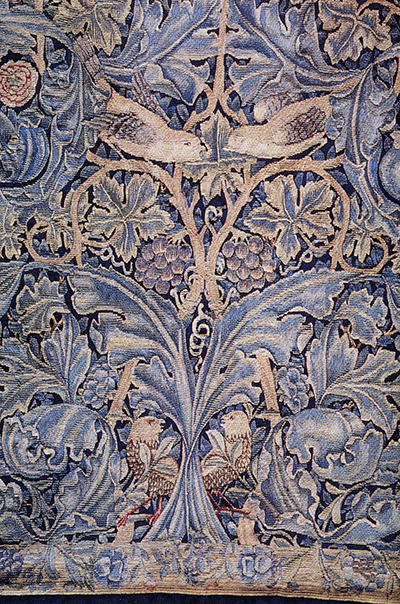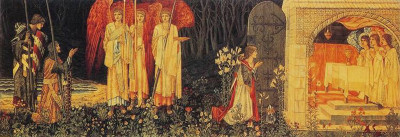Tapestries by William Morris are distinctive wall decor. These tapestries are unique in their designs due to their organic composition and sense of movement. Morris' tapestries show various scenes from religious and legendary stories to different scenes such as gardens and nature, which the textile designer enjoyed watching.
In 1877, Morris set up a tapestry loom and Acanthus and Vine was the first piece that he worked on. It took him 516 and 30 minutes to complete the piece. He finished the piece in 1879, and its design was influenced by the 16th-century large-leaf verdure tapestries that were woven in Flanders and France. Its intentionally faded appearance was an attempt to create the wall hangings that impressed Morris when he visited a hunting lodge located in the 5,900-acre Epping Forest as a young boy.
Tapestry weaving was launched at Merton Abbey in 1881 when the production of the company was incorporated at the site. Morris appointed John Henry Dearle as the production manager. Morris, John and other artists designed large tapestry commissions. The company's highly experienced weavers, who operated the looms that Morris built, executed the larger tapestries. By 1890, the tapestries by Morris had become popular with rich customers. The company made a lot of money from selling smaller tapestry cushions or panels. In 1890, Morris designed a figurative tapestry called 'The Orchard'.
Morris achieved his most important ambition in 1890 when he was commissioned to decorate Stanmore Hall's interiors. This was his last work, and he produced a set of medieval narrative tapestries. Returning to the type of Arthurian subject that he loved when he was a boy, Morris, Dearle and Burne-Jones used their wealthy customer's large budget to produce a set of opulent tapestries that were based on the popular theme the quest for the Holy Grail.
Embroidery
This was the first technique that the British textile designer adapted for commercial use. He carried out this technique before he was married. In his first attempts in stitching fabric, Morris was trying to make a version of the wall hangings from the Middle Ages that he had admired. The first ones he made were the foundation for a collection of more refined embroidered curtains and wall hangings that Morris, his spouse and their friends later created for Morris' first family home Red House located in Kent.
Printed Fabrics
In 1868, Morris' company made its first printed fabrics. They were copies of the white-ground chintzes from the 1830s, produced at Clarkson in Lancashire, North West England using blocks instead of the modern roller method. Morris stuck to this revivalist rule throughout his career. The printed fabrics were a test of his first textile design called Jasmine Trellis, a pattern that Moriss simplified in order to suit the chemical-dyed palette that Clarkson used in the manufacturing process. The textile designer was happier with 'Tulip and Willow', which was his second textile design that he made in 1873.
Morris collaborated with many talented partners and had success with the first wallpaper that he made. In the early 1870s, Morris decided to master the technical processes needed to produce his own products. He began working with the owner of a dying company in Leek, Staffordshire called Thomas Wardle. The first textile that Wardle printed was Marigold, a dense pattern that was made in 1875 that Morris used for wallpaper. Over the next several years, Morris produced many textile designs, which were mainly focusing on ordinary garden flowers such as thistles, roses, honeysuckle, columbine, bluebell, iris, larkspur (delphinium) and tulips.
Influence
Morris influence of the Victorian era decorative art inspired the restoration of the 19th-century decorative arts and crafts. Morris' ethos of production influenced the Bauhaus movement. His other aspect of preservationism was his strong desire to protect the world from the destructive effects of industrialism and pollution. For this reason, historians of the green movement considered Morris as an influential forerunner of modern environmentalism. Morris tapestries use natural elements including flowers, vines and acanthus leaves to create distinctive details and patterns.





